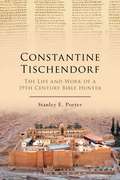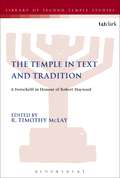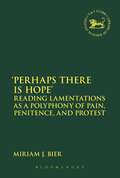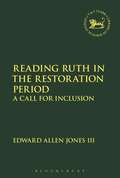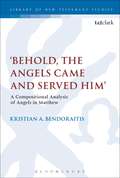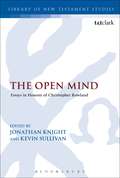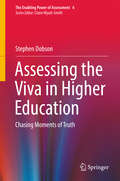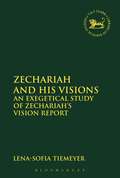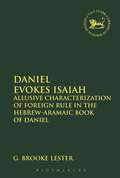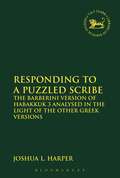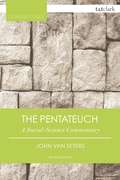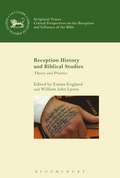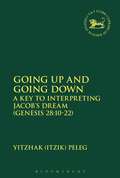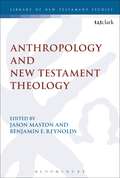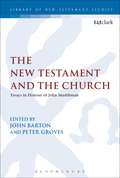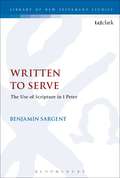- Table View
- List View
Constantine Tischendorf: The Life and Work of a 19th Century Bible Hunter
by Stanley E. PorterConstantin von Tischendorf was a pioneer. He existed in an age when biblical studies as we know it was being formed, when the quest for forgotten manuscripts and lost treasures was being undertaken with no less zeal and intrigue than it is today. It was Tischendorf who found, and preserved, the oldest extant version of the complete bible that we know of, the so-called Codex Sinaiticus, which he discovered in poor condition at St Catherine's Monastery at the foot of Mount Sinai, in 1846.With the discovery of the Codex Tischendorf, and others, was to take the study of biblical texts further than ever before, through linguistic methods, and attention to the most ancient sources available. In many ways Tischendorf was a father figure of the modern Historical Critical Method.In this short biography, Stanley E. Porter, himself one of the most respected scholars of the New Testament and Koine Greek currently writing, gives a portrait of Tischendorf's life and work, together with an annotated republication of Tischendorf's influential work on the Gospels. Published to celebrate Tischendorf's bicentenary, in 2015, this volume will be a must for those seeking to understand how the study of biblical manuscripts began, and to understand the man who discovered the oldest version of the bible as we know it.
The Temple in Text and Tradition: A Festschrift in Honour of Robert Hayward (The Library of Second Temple Studies #83)
by R. Timothy McLayThe Second Temple period is an era that marked a virtual explosion in the world of literature, with the creation, redaction, interpretation, and transmission of Jewish texts that represented diverse languages and ideologies. The creation of many of these writings coincided with the growth of the Jewish community beyond the borders of Israel; therefore, among those for whom the Temple played a diminishing role. The transition period from Temple to texts was accompanied by conflicting interpretations about the role of the Temple as well as diverse theological understandings about God and the Jewish people. Drawing on the expertise of leading specialists in Second Temple Judaism, Temple, Texts, and Traditions explores the rich traditions of the Jewish people as they were expressed and interpreted in their writings in that period, which included writings that later became recognized as Scriptures.
Jesus and Brian: Exploring the Historical Jesus and his Times via Monty Python's Life of Brian
by Terry Jones Joan E. TaylorMonty Python's Life of Brian film is known for its brilliant satirical humour. Less well known is that the film contains references to what was, at the time of its release, cutting edge biblical scholarship and Life of Jesus research. This research, founded on the acceptance of the Historical Jesus as a Jew who needs to be understood within the context of his time, is implicitly referenced through the setting of the Brian character within a tumultuous social and political background.This collection is a compilation of essays from foremost scholars of the historical Jesus and the first century Judaea, and includes contributions from George Brooke, Richard Burridge, Paula Fredriksen, Steve Mason, Adele Reinhartz, Bart Ehrman, Amy-Jill Levine, James Crossley, Philip Davies, Joan Taylor, Bill Telford, Helen Bond, Guy Stiebel, David Tollerton, David Shepherd and Katie Turner. The collection opens up the Life of Brian to renewed investigation and, in so doing, uses the film to reflect on the historical Jesus and his times, revitalising the discussion of history and Life of Jesus research. The volume also features a Preface from Terry Jones, who not only directed the film, but also played Brian's mum.
'Perhaps there is Hope': Reading Lamentations as a Polyphony of Pain, Penitence, and Protest (The Library of Hebrew Bible/Old Testament Studies #603)
by Miriam J. BierBier proposes here a strong new understanding of the Book of Lamentations, drawing on Bakhtinian ideas of multiple voices to analyse the poetic speaking voices within the text; examining their theological perspectives, and nuancing the interaction between them. Bier scrutinises interpretations of Lamentations, distinguishing between exegesis that reads Lamentations as a theodicy, in defense of God, and those that read it as an anti-theodicy, in defense of Zion. Rather than reductively adopting either of these approaches, this book advocates a dialogic approach to Lamentations, reading to hear the full polyphony of pain, penitence, and protest.
Reading Ruth in the Restoration Period: A Call for Inclusion (The Library of Hebrew Bible/Old Testament Studies #604)
by Edward Allen IIIMost scholars of the Hebrew Bible/Old Testament recognize Ruth's simplicity and beauty, yet there has been little consensus in critical scholarship related to the book's origin and purpose. Opinions on the text's date range from the early monarchic period down to the Post-Exilic period, and interpreters argue over whether the narrative served to whitewash David's lineage, or if it held Ruth out as a positive example of Gentile inclusion in the Judean community. With an eclectic approach drawing on traditional exegesis, analysis of inner-biblical allusions, comparisons of legal and linguistic data, and modern refugee research, Edward Allen Jones III argues that Ruth is, indeed, best understood as a call for an inclusive attitude toward any Jew or Gentile who desired to join the Judean community in the early Post-Exilic period. Within the narrative's world, only Boaz welcomes Ruth into the Bethlehemite community, yet the text's re-use of other biblical narratives makes it clear that Ruth stands on par with Israel's great matriarchs. Though certain segments of the Judean community sought to purify their nation by expelling foreign elements in the Restoration period, Yhwh's loving-kindness in Ruth's life demonstrates his willingness to use any person to build up his people.
'Behold, the Angels Came and Served Him': A Compositional Analysis of Angels in Matthew (The Library of New Testament Studies #523)
by Kristian A. BendoraitisAngels have been analyzed in Christological research due to their primary function as messengers and mediators between heaven and earth. Their role in the Gospel narratives, however, has been largely unexplored.Utilizing the Old Testament and sources from the Second Temple period to illustrate the variety of angel traditions, Bendoraitis identifies how these traditions are reflected in Matthew's Gospel and interprets the passages in which angels appear or are represented, resulting in a detailed exegesis of those passages which specifically mention angels. Each reference is critically analyzed in view of its role in the Gospel's narrative and in light of Matthew's redactional hand. In addition, each chapter is accompanied by a discussion of relevant traditions of angels in order to illustrate how Matthew's use of angels has facilitated his Gospel's message. The examination concludes by postulating three factors in the inclusion of angel traditions in Matthew's narrative, pertaining both to Matthew's Christology and worldview.
The Open Mind: Essays in Honour of Christopher Rowland (The Library of New Testament Studies #522)
by Kevin Sullivan Jonathan KnightThis Festschrift draws on the research interests of Christopher Rowland. The collection of essays comes from former doctoral students and other friends, many of whom shed light on the angelic contribution to the thought-world of developing Christianity. The significance of the Jewish contribution to developing Christian ideology is critically assessed, including the impact of the original Jewish sources on the earliest Christian belief. The distinguished contributors to this volume include April DeConick, Paul Foster, John Rogerson, Tobias Nicklas and Andrei Orlov.
'And He Will Take Your Daughters...': Woman Story and the Ethical Evaluation of Monarchy in the David Narrative (The Library of Hebrew Bible/Old Testament Studies)
by April D. WestbrookApril Westbrook explores the intentional inclusion of woman stories (those displaying significant female presence) within the David narrative in the books of Samuel. These stories are made prominent by the surprisingly high number of their occurrences as well as the sequentially progressive literary pattern in which they occur in the larger narrative. Westbrook shows that the dramatic and detailed accounts within the story repeatedly challenge the reader to consider the experiences of women and their contribution to the purpose of the larger narrative. When viewed collectively, these woman stories serve to stir the reader's responses in ways which systematically call into question the nature of the monarchy itself as a power system-both its impact upon the nation and upon the kings who rule. Although King David is often held up as a paragon of virtue, the experiences of the women in his life frequently reveal a different side of his character, and the reader must wrestle with the resultant ambiguity. In the process, the reader must also think deeply about the inevitably negative aspects of hierarchical social structures and why this biblical text is apparently designed to press the reader toward unavoidable and uncomfortable personal confrontation with these realities concerning the use of power within community life.
Assessing the Viva in Higher Education: Chasing Moments of Truth (The Enabling Power of Assessment #6)
by Stephen DobsonThis book makes the case for a revival in interest in the viva. As an oral assessment of a treatise or dissertation or of a student’s performance in art or dance the viva has a long history dating back to the time of the Greeks. It can be found today in the form of professional, vocational and academic vivas, where a judgment of oral performance is required to gain entry into a profession or community of scholars.In a time when there are scandals about students selling essays to other students, the viva provides a fertile ground for probing the student to see whether they are in fact the authors of the work being assessed and know its content and how to think cognitively or otherwise.Given that we actually know so little about the viva, the book theorises the viva based on a unique sample of vivas that have been filmed or in which the author himself has been participant, and discusses why its format is so different in Anglo-Saxon languages and Latin and other languages.The book offers educational policy-makers and examiners a trade-off between arguments in support of the viva and the demand for other, ever more cost-effective forms of assessment as the numbers of both undergraduate and postgraduate students threaten to increase. It also argues that with demand in the labour market for qualified graduates who are better equipped with transferable skills, such as the ability to communicate complex ideas verbally in a competent, well-argued fashion and not merely through the use of rhetoric, what appear to be cost-effective forms of assessment in the short run (e.g. written exams with standardised questions or multiple choice) may actually in the long run be of less value if we are investing in a future workforce with so-called 21st century communication skills.If the viva were abandoned, the student would be robbed of the opportunity to stage a defence.
Zechariah and His Visions: An Exegetical Study of Zechariah's Vision Report (The Library of Hebrew Bible/Old Testament Studies #605)
by Lena-Sofia TiemeyerDid Zechariah really see visions? This question cannot be definitely answered, so the idea must remain a hypothesis. Here, Tiemeyer shows that this hypothesis is nonetheless reasonable and instrumental in shedding light on matters in Zechariah's vision report that are otherwise unclear. Tracking through each verse of the text, the key exegetical problems are covered, including the topics of the distinction between visions and dreams, dream classification, conflicting sources of evidence for dream experiences, and rhetorical imagery as opposed to dream experience. Further attention is focused on the transmission of the divine message to Zechariah, with the key question raised of whether a visual or oral impression is described. Tiemeyer's study further demonstrates that Zech 1-6 depicts a three-tier reality. This description seeks to convey the seer's visionary experience to his readers. In a trance state, Zechariah communicates with the Interpreting Angel, while also receiving glimpses of a deeper reality known as the 'visionary world.'
Daniel Evokes Isaiah: Allusive Characterization of Foreign Rule in the Hebrew-Aramaic Book of Daniel (The Library of Hebrew Bible/Old Testament Studies #606)
by G. Brooke LesterLester argues here that the book of Daniel contains a complex but poetically unified narrative. This can be identified through certain narrative qualities, including the allusion to Isaiah throughout, which uniquely contributes to the narrative arc. The narrative begins with the inauguration of foreign rule over Israel, and concludes with that rule's end. Each stage of the book's composition casts that foreign rule in terms ever-more-reminiscent of Isaiah's depiction of Assyria. That enemy is first conscripted by God to punish Israel, but then arrogates punitive authority to itself until ultimately punished in its turn and destroyed. Each apocalypse in the book of Daniel carries forward, in its own way, that allusive characterization.Lester thus argues that an allusive poetics can be investigated as an intentional rhetorical trope in a work for which the concept of “author” is complex; that a narrative criticism can incorporate a critical understanding of composition history. The “Daniel” resulting from this inquiry depicts Daniel's 2nd-century Jewish reader not as suffering punishment for breaking covenant with God, but as enduring in covenant faithfulness the last days of the “Assyrian” arrogator's violent excesses. This narrative problematizes any simplistic narrative conceptions of biblical Israel as ceaselessly rebellious, lending a unique note to conversations about suffering and theodicy in the Hebrew Bible, and about anti-Judaic habits in Christian reading of the Hebrew Bible.
The God Ezekiel Creates (The Library of Hebrew Bible/Old Testament Studies #607)
by Paul M. Joyce Dalit Rom-ShiloniThis powerful collection of essays focuses on the representation of God in the Book of Ezekiel. With topics spanning across projections of God, through to the implications of these creations, the question of the divine presence in Ezekiel is explored. Madhavi Nevader analyses Divine Sovereignty and its relation to creation, while Dexter E. Callender Jnr and Ellen van Wolde route their studies in the image of God, as generated by the character of Ezekiel. The assumption of the title is then inverted, as Stephen L. Cook writes on 'The God that the Temple Blueprint Creates', which is taken to its other extreme by Marvin A. Sweeney in his chapter on 'The Ezekiel that God Creates', and finds a nice reconciliation in Daniel I. Block's chapter, 'The God Ezekiel Wants Us to Meet.' Finally, two essays from Christian biblical scholar Nathan MacDonald and Jewish biblical scholar, Rimon Kasher, offer a reflection on the essays about Ezekiel and his God.
Responding to a Puzzled Scribe: The Barberini Version of Habakkuk 3 Analysed in the Light of the Other Greek Versions (The Library of Hebrew Bible/Old Testament Studies #608)
by Joshua L. HarperIn part one of this book Joshua L. Harper is able to demonstrate the following aspects of the Barberini version: when compared with the other Greek versions, it appears that the Barberini version was originally independent of the Septuagint but has been influenced by it in transmission. The Barberini version was probably translated no earlier than the later books of the Septuagint (that is, around the first century BC), and no later than the mid-third century AD. The style, methods of translation, and exegetical affinities suggest that the translator was primarily concerned with producing stylistic, understandable Greek rather than with conforming closely to the Hebrew source text. The translator was probably Jewish, particularly since some readings resonate with Jewish exegetical traditions. The relatively polished Greek suggests that the translator had received some formal Greek education, perhaps in a Hellenistic Jewish community. In the second part of this work Harper provides text, translation, and notes for the major Greek versions. The Barberini version has been analysed in particular detail, with regard to lexical and syntactical translation technique, as well as matters of style.
Jesus: Critical Issues in Feminist Christology (T&T Clark Cornerstones)
by Elisabeth Schüssler FiorenzaIn Jesus: Miriam's Child, Sophia's Prophet Elisabeth Schüssler Fiorenza makes a unique contribution to two quite different discussions of Jesus the Christ. On the one hand, she looks at biblical christology from a critical feminist perspective in the tradition of liberation theology. On the other, she examines the feasibility of a feminine christology by considering such problems as Christian anti-Judaism, ideological justification of domination, religious exclusivism and the formation of patriarchal identity. Re-imagining the Jesus movement in a feminist key transcends the boundaries set by history, gender and doctrine. By assessing various Jesus traditions and interpretations in terms of whether they can engender liberating visions for today, Schüssler Fiorenza seeks to challenge and transform a Christianity dominated by masculinity and exclusivist theological frameworks so that it offers a vision of justice and well-being for all, the central image in which is the reign, the coming world, of God. This Cornerstones edition features a new extended introduction which takes into account the developments in the field since the work was originally published in 1994.
The Pentateuch: A Social-Science Commentary (T&T Clark Cornerstones)
by John Van SetersIn this magisterial overview of the Pentateuch John Van Seters reviews the various historical-critical attempts to read it that arise from notions about the social evolution of Israel's religion and culture. Is the Pentateuch an accumulation of folk traditions, a work of ancient historiography, a document legitimizing religious reform? In dialogue with competing views, Van Seters advocates a compositional model that recognizes the social and historical diversity of the literary strata. Van Seters argues that a proto-Pentateuchal author created a comprehensive history from Genesis to Numbers that was written as a prologue to the Deuteronomistic History (Deuteronomy to 2 Kings) in the exilic period and later expanded by a Priestly writer to make it the foundational document of the Jerusalem temple community.This social-science commentary on the Pentateuch is renowned as one of the most influential volumes on this group of texts. For the new edition Van Seters has revised several sections of the text, updating and integrating new bibliographical items, and refining the text where necessary. A reflective preface summarizes these changes and developments for the reader's convenience.
Concerning the Nations: Essays on the Oracles Against the Nations in Isaiah, Jeremiah and Ezekiel (The Library of Hebrew Bible/Old Testament Studies)
by Andrew Mein Else K. Holt Hyun Chul KimIsaiah, Jeremiah, and Ezekiel share much in common. They address the pivotal times and topics associated with the last stages of the monarchical history of Israel, and with the development of new forms of communal and religious life through exile and beyond. One important structural component of all three books is a substantial section which concerns itself with a range of foreign nations, commonly called the “Oracles against the Nations”, which form the focus of this book. These chapters together present the most up-to-date scholarship on the oracles - an oft-neglected but significant area in the study of the prophetic literature. The particular characteristics of Isaiah, Jeremiah (both Masoretic Text and Septuagint versions), and Ezekiel, are discussed showcasing the unique issues pertinent to each book and the diverse methods used to address them. These evident differences aside, the Oracles Against the Nations are employed as a springboard in order to begin the work of tracing similarities between the texts. By focusing on these unique yet common sections, a range of interrelated themes and issues of both content and method become noticeable: for example, though not exhaustively, pattern, structure, language, comparative history, archaeology, sociology, politics, literature, imagery, theme, theology, and hermeneutical issues related to today's context. As a result this collection presents a range of cutting-edge approaches on these key prophetic books, and will provide a basis for further comparative study and reflection.
Reception History and Biblical Studies: Theory and Practice (The Library of Hebrew Bible/Old Testament Studies)
by Emma England William John LyonsHow do we begin to carry out such a vast task-the examination of three millennia of diverse uses and influences of the biblical texts? Where can the interested scholar find information on methods and techniques applicable to the many and varied ways in which these have happened?Through a series of examples of reception history practitioners at work and of their reflections this volume sets the agenda for biblical reception, as it begins to chart the near-infinite series of complex interpretive 'events' that have been generated by the journey of the biblical texts down through the centuries. The chapters consider aspects as diverse as political and economic factors, cultural location, the discipline of Biblical Studies, and the impact of scholarly preconceptions, upon reception history. Topics covered include biblical figures and concepts, contemporary music, paintings, children's Bibles, and interpreters as diverse as Calvin, Lenin, and Nick Cave.
Children’s Bibles in America: A Reception History of the Story of Noah’s Ark in US Children’s Bibles (The Library of Hebrew Bible/Old Testament Studies)
by Russell W. DaltonChildren's Bibles have been among the most popular and influential types of religious publications in the United States, providing many Americans with their first formative experiences of the Bible and its stories. In Children's Bibles in America, Russell W. Dalton explores the variety of ways in which children's Bibles have adapted, illustrated, and retold Bible stories for children throughout U.S. history. This reception history of the story of Noah as it appears in children's Bibles provides striking examples of the multivalence and malleability of biblical texts, and offers intriguing snapshots of American culture and American religion in their most basic forms. Dalton demonstrates the ways in which children's Bibles reflect and reveal America's diverse and changing beliefs about God, childhood, morality, and what must be passed on to the next generation. Dalton uses the popular story of Noah's ark as a case study, exploring how it has been adapted and appropriated to serve in a variety of social agendas. Throughout America's history, the image of God in children's Bible adaptations of the story of Noah has ranged from that of a powerful, angry God who might destroy children at any time to that of a friendly God who will always keep children safe. At the same time, Noah has been lifted up as a model of virtues ranging from hard work and humble obedience to patience and positive thinking. Dalton explores these uses of the story of Noah and more as he engages the fields of biblical studies, the history of religion in America, religious education, childhood studies, and children's literature.
Going Up and Going Down: A Key to Interpreting Jacob's Dream (Gen 28.10-22) (The Library of Hebrew Bible/Old Testament Studies)
by Yitzhak Itzik PelegIn Going Up and Going Down Yitzhak Peleg argues that the story of Jacob's dream (Genesis 28.10-22), functions as a mise en abyme ('as a figure, trope or structure that somehow reflects in compact form, in miniature, the larger structure in which it appears', Greenstein). Close examination reveals that focusing on the vision of Jacob's dream and understanding it as a symbolic dream facilitates an explanation of the dream and its meaning. Scholars have historically classified the dream as theophany, the purpose of which is to explain how Beth-El became a sacred place, and as such the vision in Jacob's dream is generally accepted as merely ornamental, or even lacking a message in itself. Whilst Peleg does not contradict or seek to go against identification of the dream as theophany, he sees a more nuanced purpose behind its presentation. Peleg's proposal is that the description of the vision, and especially that of the movement of the angels, is not embellishment, supplementation or scenic background, of God's message, but that it directly symbolizes the path taken by the Patriarchs to and from the Promised Land. Furthermore, the narrative context and visual description in the dream in which 'Angels of God were going up and down it' appears when Jacob is on his way to Harran, that is to say, when he is about to leave Israel.
Ancient Education and Early Christianity (The Library of New Testament Studies #533)
by Matthew Ryan Hauge Andrew W. PittsWhat was the relationship of ancient education to early Christianity? This volume provides an in-depth look at different approaches currently employed by scholars who draw upon educational settings in the ancient world to inform their historical research in Christian origins. The book is divided into two sections: one consisting of essays on education in the ancient world, and one consisting of exegetical studies dealing with various passages where motifs emerging from ancient educational culture provide illumination. The chapters summarize the state of the discussion on ancient education in classical and biblical studies, examine obstacles to arriving at a comprehensive theory of early Christianity's relationship to ancient education, compare different approaches, and compile the diverse methodologies into one comparative study. Several educational motifs are integrated in order to demonstrate the exegetical insights that they may yield when utilized in New Testament historical investigation and interpretation.
Anthropology and New Testament Theology (The Library of New Testament Studies #529)
by Jason Maston Benjamin E. ReynoldsThis volume considers the New Testament in the light of anthropological study, in particular the current trend towards theological anthropology. The book begins with three essays that survey the context in which the New Testament was written, covering the Old Testament, early Jewish writings and the literature of the Greco –Roman world. Chapters then explore the anthropological ideas found in the texts of the New Testament and in the thought of it writers, notably that of Paul. The volume concludes with pieces from Brian S. Roser and Ephraim Radner who bring the whole exploration together by reflecting on the theological implications of the New Testament's anthropological ideas.Taken together, the chapters in this volume address the question that humans have been asking since at least the earliest days of recorded history: what does it mean to be human? The presence of this question in modern theology, and its current prevalence in popular culture, makes this volume both a timely and relevant interdisciplinary addition to the scholarly conversation around the New Testament.
Jesus and the Thoughts of Many Hearts: Implicit Christology and Jesus’ Knowledge in the Gospel of Luke (The Library of New Testament Studies #530)
by Collin BullardIn the Gospel of Luke, the aged Simeon foresees the future opposition which Jesus will face (2.34-35) and concludes his ominous oracle with a vivid description of the final outcome of Jesus' ministry: '…so that the thoughts of many hearts may be revealed' (2.35). Bullard presents an investigation of the narrative and Christological significance of this 'revelation of thoughts' in the ministry of Jesus, especially as this revelation is demonstrated and fulfilled in Jesus' ability to know the thoughts in the hearts of those whom he encounters throughout the Gospel. Bullard first explores a number of potential literary parallels to Jesus' knowledge of thoughts in Greco-Roman and Jewish sources. He then undertakes a narrative- and redaction-critical study which spans the Gospel in order to provide a full description of the 'revelation of thoughts' in Jesus' ministry. What Jesus knows and how he knows it are fundamental features of his identity, governing how he relates to others in the narrative. Yet the issue of whether, or how, Jesus' knowledge of thoughts fits into Luke's overall Christological portrait has been given only superficial attention. Bullard offers an account of the Christological significance of Jesus' knowledge that makes sense of both its internal narrative development and external literary parallels.
The New Testament and the Church: Essays in Honour of John Muddiman (The Library of New Testament Studies #532)
by John Barton Peter GrovesJohn Barton and Peter Groves present a range of chapters by leading scholarly voices from the worlds of biblical studies and the Church, looking at the study of the New Testament within and around the Church and the impact it has had and can have on Christian theology. The essays in the volume adopt a style of critical engagement with biblical texts, through the prism of a modern and living Church. The focus of the volume is thus not only upon the New Testament itself, but upon how reading the New Testament is important for dialogue within the Church and within Christian denominations. Among the highly distinguished contributors are John Barton, Eric Eve, Mark Goodacre, Christopher Rowland, and Rowan Williams.
Written To Serve: The Use of Scripture in 1 Peter (The Library of New Testament Studies #547)
by Benjamin SargentThe use of Scripture in 1 Peter has been subject to much extensive analysis in the last thirty years. In Written to Serve Benjamin Sargent offers an up to date and comprehensive analysis of how 1 Pet 1.10-12 offers a 'hermeneutic,' providing an insight into how Scripture is interpreted in the letter. Sargent also argues that the relation of 1.10-12 has been misunderstood. Rather than offering a Christological hermeneutic with a focus on the suffering and glories of Christ, Sargent asserts that the primary importance of 1.10-12 is its orientation of the prophetic witness towards the eschatological community as an act of service. Similarly, rather than offering a theological narrative of continuity between Israel and Christian communities, 1.10-12 may be seen to suggest a narrative of profound discontinuity in which the community in the present is elevated above God's people of the past.
Wisdom Intoned: A Reappraisal of the Genre 'Wisdom Psalms' (The Library of Hebrew Bible/Old Testament Studies)
by Simon Chi-Chung CheungIt has been hard to categorise and identify the 'Wisdom psalms' within the Psalter. Interpreters have produced different lists of wisdom psalms of greatly varying lengths, and individual scholars often change their choices over time. Cheung re-examines the issues at stake in identifying this group of psalms in order to better describe the configuration of this psalmic genre. Past scholarship has failed to settle this issue because of the use of unfit criteria and an ill-understood concept of genre. With the aid of the concepts of 'family resemblance' and 'prototypes', this book proposes to define 'wisdom psalms' as a psalm family which is characterised by a wisdom-oriented constellation of its generic features. Three such features are identified after a fresh assessment of the most typical characteristics of 'wisdom literature'. This proposed method is put to test in the extensive study of seven psalms (37, 49, 73, 128, 32, 39, and 19) and the three criteria are verified to be suitable descriptors of the 'wisdom psalm' family. Cheung also explores questions related to the wisdom-cult disparity, Joban parallels as wisdom indicators, and the wisdom-orientation of 'torah psalms'.
